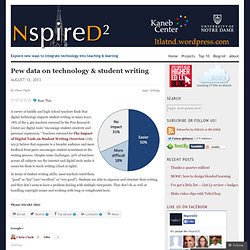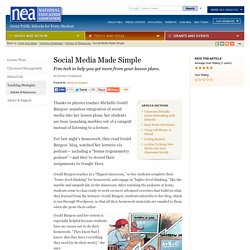

Boy Builds Braille Printer Out Of Lego. What do you get when you put a Lego robotics kit, basic tools and a creative mind together?

A Braille printer. Shubham Banerjee, 12, talks to NPR's Scott Simon about his project to help the blind. Copyright © 2014 NPR. For personal, noncommercial use only. See Terms of Use. Shubham Banerjee has done something utterly remarkable: the seventh grader has used a $350 robotics kit made by Lego, plus some basic items from the hardware store, to build a braille printer. SHUBHAM BANERJEE: Sure, no problem. SIMON: Well, what inspired you to try and use a Lego kit to make a braille printer? BANERJEE: First of all, I've been loving Legos since I was 2 years old. SIMON: Yeah. BANERJEE: So, one of the flyers came to my parents and it said help the blind with donations. SIMON: Can you tell us how it works without giving away the genius of your invention? BANERJEE: OK. BANERJEE: So, you would go to the brick, which is the heart of the robot, and there's up, down, left, right buttons that you can use.
Y Combinator's New Nonprofit Helps Tech Companies Teach Kids To Code. Y Combinator nonprofit CodeNOW aims to teach high school students, especially minorities and girls, programming skills with its in-person coding workshops.

While the organization has taught more than 300 students the fundamentals of programming, it hopes to have a bigger impact, and on Thursday launched a product that it says could potentially reach hundreds of thousands of students. Called CodeNOW in a Box, the program will enable tech companies to host their own programming training sessions. The organization said more than 45% of students are female, and 95% of students receive free or subsidized lunches. The vast majority of students who attend CodeNOW's workshops have never written a line of code before. "CodeNOW's success comes from people responding to our idea and taking action," founder and CEO Ryan Seashore told Fast Company.
The program is set up so students attend three days of training over four weeks, and students are assigned about five hours of homework in between. Obama, tech firms to announce software donations to U.S. schools. Advantages of the BYOT classroom. Pew data on technology & student writing. A survey of middle and high school teachers finds that digital technology impacts student writing in many ways. 78% of the 2,462 teachers surveyed by the Pew Research Center say digital tools “encourage student creativity and personal expression.”

Teachers surveyed for The Impact of Digital Tools on Student Writing Overview (July 2013) believe that exposure to a broader audience and more feedback from peers encourages student investment in the writing process. Despite some challenges, 50% of teachers across all subjects say the internet and digital tools make it easier for them to teach writing (chart at right). In terms of student writing skills, most teachers rated them “good” or “fair” (not “excellent” or “very good”). Students are able to organize and structure their writing, and they don’t seem to have a problem dealing with multiple viewpoints. They don’t do as well at handling copyright issues and working with long or complicated texts. Like this: Like Loading...
Related In "News" Google Apps. iPads in Schools. Social Media Made Simple. By Emma Chadband Found In: advice & support Thanks to physics teacher Michelle Gould Burgess’ seamless integration of social media into her lesson plans, her students are busy launching marbles out of a catapult instead of listening to a lecture.

For last night’s homework, they read Gould Burgess’ blog, watched her lectures via podcast— including a “bonus trigonometry podcast”—and they’ve stored their assignments in Google Docs. Gould Burgess teaches in a “flipped classroom,” so her students complete their “lower-level thinking” for homework, and engage in “higher-level thinking,” like the marble and catapult lab, in the classroom.
After watching the podcasts at home, students come to class ready to work on more advanced exercises that build on what they learned from the lectures. Gould Burgess said her system is especially helpful because students have no excuse not to do their homework. Classroom-friendly Social Networking with Edmodo It also helps McDonald speed up the grading process.